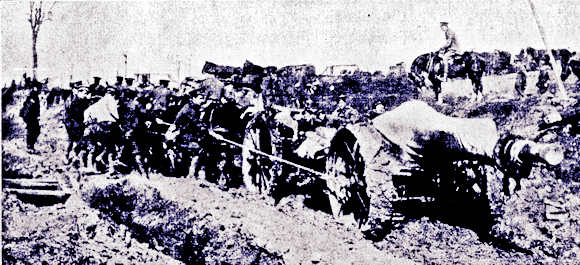 |
| British Artillery Piece Moving into Position, Somme Battlefield |
William Philpott is Professor of the History of Warfare in the Department of War Studies at King’s College, London. He is a specialist in the operations on the Western Front and has published extensively on the subject. He has given us an elegant, sophisticated, and intellectually rigorous analysis of a turning-point campaign of the Great War. Much has been written about the Somme, including detailed studies of individual actions making up the five-month-long struggle.
Most of these emphasize the suffering and futility of the affair, the ineptitude and bull-headedness of British commanders, most particularly Sir Douglas Haig. Philpott, on the other hand, sees the Somme as a victory establishing British and French material and tactical superiority over the previously dominant German Army. He describes in detail not only the battles themselves but also the meticulous planning and preparation (not to mention the inter-Allied squabbling) that went into them
He also offers insight into the strengths and weaknesses of the opposing commanders and analysis of evolving British and French battle tactics, emphasizing the flexible role of platoons of riflemen, grenadiers, and automatic riflemen. As historian Richard Holmes in his review of this book put it, "Something in me shrinks from using the phrase ‘learning curve’, as if the rolling downland was graph paper and the all-too-numerous crosses simple measures of combat effectiveness. But it is nonetheless true to say that the growth of British tactical skill and the degradation of German fighting power were two of the Somme’s many interlocking themes."
The attrition suffered by the German Army on the Somme obliged its high command to withdraw in the spring of 1917 from the Noyon salient and hunker behind the Siegfried Stellung (Hindenburg Line), shortening their line by some 40 km and freeing 14 divisions for strategic reserve. Bottom line: while the Anglo-British effort on the Somme did not achieve breakthrough, it did lay the groundwork for victory in 1918.
Note: Three Armies on the Somme was originally published in Britain as Bloody Victory: The Sacrifice on the Somme and the Making of the Twentieth Century. Under that title it was awarded the Tomlinson Prize for best World War On book published in 2011.

An excellent book. It provides a much needed correction to the tendency to view the Somme as a purely British versus German affair. Although in all fairness, the French themselves probably contributed to this attitude, since they tended to view Verdun as "their" battle.
ReplyDelete